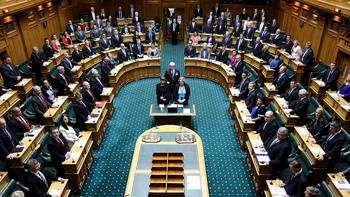The final price tag for Auckland’s controversial Queen Street pedestrianisation project - which launched a High Court challenge in 2021 by aggrieved landlords - has come in at $12.8 million, with the mayor and other civic figures claiming its costing and delivery “wasn’t really transparent”.
Auckland Council originally priced a Queen St “makeover” project at $1.1m in early 2021, after significant backlash over plastic Covid social distancing barriers that reduced the city’s main shopping thoroughfare to one lane.
More than three years after the initial effort to pedestrianise the street, the final component of the project is still being constructed, replacing wooden planking with stone pavers and upgraded planters between Shortland and Customs Sts.
Upon his election a year ago, Auckland mayor Wayne Brown outlined an agenda to reform Auckland Transport (AT) saying “they are there to serve the way we live, not change the way we live”.
Brown told the Herald this week he was not particularly familiar with the origins of the Queen St project but “there are quite a few old legacy projects I wouldn’t [endorse] working their way through the system”.
“I’m on top of the big-cost mistakes like City Rail Link.”
Auckland Central MP Chlöe Swarbrick was a supporter of the Auckland Council’s Access for Everyone project of which the pedestrianisation of Queen St was part of. But Swarbrick expressed some frustration around the prioritisation of the council’s city centre funding.
“The CRL is about to open in a few years so now really is the time to do this stuff. But we could do a lot more with what we have without having to do massive infrastructure projects,” Swarbrick said.
“There’s just so many more things council could be doing in vibrancy and actually unlocking the talent and opportunity that we already have here, but it seems to be focused solely on these infrastructure projects and doing these consultation carousels.”
/cloudfront-ap-southeast-2.images.arcpublishing.com/nzme/FGUDUVJW3GT3ELS3HBBHZKOIMA.jpg) Auckland Central MP Chlöe Swarbrick. Photo / Michael Craig
Auckland Central MP Chlöe Swarbrick. Photo / Michael Craig
/cloudfront-ap-southeast-2.images.arcpublishing.com/nzme/JYVB6L2MNJAGHGRMFIG34MCV4U.JPG)
The local MP said there were simpler options, such as ease of access to street food licences, that could massively enhance the city centre.
But Swarbrick also said she found it “incredibly frustrating” New Zealand tends to take a “peculiar exceptionalist stance that all of these things that have worked in all these other jurisdictions” such as a pedestrian-friendly city centre “for some reason aren’t going to work here”.
Viv Beck, Auckland central business association Heart of the City chief executive, was part of a group of disgruntled businesses and property owners who filed an unprecedented High Court action, in April 2021, against the project.
As the project is now nearing completion, Viv has reflected on how the street functions.
“On the positive side, people do seem to like the public space, having extra public space and they find the sort of ease of walking around good.
But Beck reiterated a long-standing frustration about the decision to not allow cars to access the section of Queen St outside Aotea Centre and the Civic.
“We are supportive of public transport, but it’s just that ongoing sort of commentary from AT you know, the arts precinct at night should be an accessible place for everyone,” Beck said.
“The lack of willingness over a long period of time to talk about how that can be improved.
“That’s Queen Street, you know, and, and I still get comments from, physios [with offices on the street] and it’s difficult [access] for someone who’s, you know, got an injury. I get comments from emergency services and cabs about [how] access is difficult.”
/cloudfront-ap-southeast-2.images.arcpublishing.com/nzme/S5AY6D5BEVH7VLBSSDBVZNJZX4.jpg) Construction work on Queen St between Customs St and Shortland St. Photo / Michael Craig
Construction work on Queen St between Customs St and Shortland St. Photo / Michael Craig
Beck was also critical of the communication from AT on how much the Queen St pedestrianisation trial would cost and the more permanent construction phase that has been drawn out for two years.
“Even those early works, we thought those, plastic [pylons] that they wouldn’t last - we actually told them that. But they went ahead anyway. So, you know, they’re digging it up now and making it like the rest of it. But the reality is, it wasn’t really transparent.”
Paradoxically AT’s decision to remove private vehicles taxis and rideshare vehicles from mid-Queen St, between the Civic Theatre and Aotea Square, was argued as a way of enhancing the city’s arts precinct.
“Pedestrian priority is key as this area is completed and re-invigorated post-Covid,” AT head of transport and parking compliance Rick Bidgood said.
“The city centre needs to enjoy good commerce, so commercial vehicles delivering goods are able to use this lane along with public transport and people travelling on two wheels.”
Fines are given to vehicles that drive through this section twice - with a pardon for a first infringement.
In September 2022, Bidgood said AT had issued 51,000 warning notices to cars that have used that section of the road.
Auckland Council head of city centre programmes Jenny Larking clarified to the Herald the original price tag of $1.1m was only for the phase 1 trial changes that extended from Customs St to Shortland St, including Fort St, intended to be in place until at least September 2021. The $12.8m figure relates to the full and completed project from Customs St through to Mayoral Drive and includes the original $1.1m.
“This project is a key part of the work by the council group and the business community to make the city centre more attractive and people-focused,” Larking said.
“Footfall at the bottom of Queen Street, on the east side – the site of the current works, through 2021 was 4.3 million people; in 2022 it had grown to 5.2 million and this year it is already at 5.4 million, with November and December – the two busiest months last year – still to come.”
Larking maintained the programme of works is within budget with about two-thirds of the funding coming from targeted rates, and the remainder from general rates.
/cloudfront-ap-southeast-2.images.arcpublishing.com/nzme/6O6D4B4EWBF2HBLFDZISKVAUXI.jpg) Viv Beck, chief executive of Heart of the City. Photo / File
Viv Beck, chief executive of Heart of the City. Photo / File
The group called Save the Queen Street society was made up of 13 committee members including property owners and business figures who applied for an injunction to halt it, arguing it was unlawful and caused “significant economic harm”.
Property developer and Queen St landlord Andrew Krukziener spearheaded the Save Queen Street group, which eventually withdrew its High Court appeal for a judicial review after compromises to the extent of the streetscape alterations.
“It was a mistake then. It’s a mistake now,” Krukziener said.
“Everything they’ve done is totally unnecessary and has taken away the utility and ability for the street to be used intelligently.
“I was in my car the other day and there was a bus driver with the window open and I said: I said, how long have you been a bus driver? He said 30 years. I said, mate what do you think of what they’ve done to Queen Street? He said it’s the most stupid thing I’ve ever seen. And it’s coming directly from the bus driver who this idiocy is supposed to have been making it better for.”
The property developer and landlord said he believed the population level of Auckland and its spread-out geography mean the city will be dependent on cars for decades and it is a denial to think older people can rely on cycling or busses exclusively.
/cloudfront-ap-southeast-2.images.arcpublishing.com/nzme/KXZUCQQZH4KECZXAQ4DVXGZQL4.jpg) Queen St property owner Andrew Krukziener (right) with local businessman Oliver Kong. Photo / Sylvie Whinray
Queen St property owner Andrew Krukziener (right) with local businessman Oliver Kong. Photo / Sylvie Whinray
He also the original price tag of about $1m should have been more than enough to deliver the full permanent street changes.
He said the $13m price tag was “ridiculous” for “a bit of paving”.
“I fought against it, very, very hard and got some concessions. But fundamentally, you know, the council ended up doing 70 per cent of what they wanted to do and they should have got, should have done, 0 per cent.”
Take your Radio, Podcasts and Music with you









